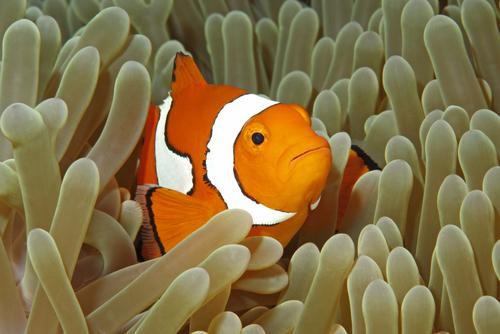- Home
- Play & Learn Home
- Online Enrichment
- Experience Modern Israel
- Israel It's Complicated
- Jewish and Me
- Jewish Holidays Jewish Values
- Jewish Values in Genesis and Jewish Values in Exodus
- Min Ha’aretz
- Our Place in the Universe
- Simply Seder
- The Prophets: Speaking Out for Justice
- Making T'filah Meaningful
- Make, Create, Celebrate
- Yom Haatzmaut Resources
- Hebrew Apps
- About The OLC
- What is the OLC?
- Introduction
- Get Started
- Resources
- OLC Content
- Parent Materials
- See My OLC Classes
- Store
Eilat's Bounty of Beauty
"How many are the things you have made, O God; you have made them all with wisdom: the Earth is full of your creations."
Psalms 104:24
Imagine that you've stumbled upon an alien visitor to Earth. The creature is busy gathering information about life on our planet, when suddenly, one of its 100 blinking eyes spies you. The odd-looking intruder snatches you up in its slippery, jelly like arms, and whisks you away to a hidden starship. Once aboard the vessel, the extraterrestrial treats you with respect and a keen sense of curiosity. It's clear that it simply wants to ask you about the diversity of life on the planet. Too bad that the foreigner from outer space grabbed you- a landlubber! Like all human beings, you live on a measly 1 percent of the total living space on Earth. What could you possibly tell your captor about life's variety? After all, 80 percent of all living things exist beyond your view- under the sea.
Clowning Around with Danger
You might be able to tell the alien plenty after you visit Eilat's Underwater Observatory Marine Park, located on the shore of the Red Sea, near the southern tip of Israel. Ayelet Moskowitz, 14, from Modi'in, recently spent a sun-drenched day at the park, unable to believe her eyes. Entering the Aquarium Museum, which has 38 tanks holding more than 500 species of fish, Ayelet raves, "It's so beautiful here; look at all the different types of fish." One tank catches her eye. In it are several bright-orange clown fish swimming leisurely among their dangerous host, the sea anemone (uh-nehm-uh-nee). Anemones look like harmless plants but they're not; they're predatory animals. What appear to be wispy, narrow stalks swaying gently in the water are actually poisonous tentacles. When a fish touches the anemone's tentacles, tiny capsules of poison explode and paralyze or kill the unsuspecting fish. Then, effortlessly, the anemone brings its prey into its waiting mouth.
Clown fish, however, are immune to the anemone's poison. They hide from predators in the middle of the deadly tentacles. In return for their protection, clown fish keep sea anemones clean, nibbling away at the harmful debris that collects on their host's tentacles. "The clown fish and anemone manage to live together and divide the food among themselves," Ayelet observes. "Too bad people can't get along that well."
Saving a Species
Next, Ayelet strolls outside toward the Turtle and Stingray Pool. As she approaches the sparkling blue water, she sees two huge, wrinkled sea turtles inching their way along the white sand at the bottom of the pool. Despite poor vision and an inability to raise their heads more than a few inches out of the water, female sea turtles often swim more than 1,000 miles to lay their eggs on the same beach where they were born. One of nature's greatest mysteries is how these turtles navigate such a treacherous journey. Eilat's Underwater Observatory is the only facility in the world that successfully breeds this remarkable endangered species.
Sea-ing Miracles
Hodaya of Karnei Shomron and Yishai of Kiryat Shmuel, both 11, also enjoyed the day at the marine park. "When I come to such a place, it strengthens my belief that God can do anything," says Yishai, staring in awe at several tiny butterfly fish swimming in an aquarium. The thin, disk-shaped fish have pointy noses and a black spot on their tail that resembles the fish's eye. Predators are confused by the fake eye and can't anticipate in which direction the butterfly fish will flee. The split second of indecision is all the butterfly fish needs to escape. "There's nothing more beautiful than to see this level of creation in the sea," says Sara Miroz, the park's educational supervisor. "Every color or spot on the fish sends a message to other fish." But some messages are lies, warns Hodaya. She's referring to a fake cleaner-fish that has captured her attention. Instead of cleaning the client fish, the faker takes a delicious bite out of it! "Everything has its own way of life and its own food," she laughs.
Peering out from a window in one of the observatory's underwater halls, visitors enjoy a bounty of beauty. Yishai is moved by what he sees, and recalls a verse from Psalm 104: "How many are the things You have made, O God; You have made them all with wisdom; the Earth is full of Your creations." Ayelet agrees. "Now, when I read about the glory of creation," she smiles, "I'll see it in my mind." As if on cue, a school of Picasso fish swim by, their faces dappled with purple and yellow, as if the famous artist personally painted them. The handiwork in this case, though, belongs to a far greater Artist.
0
The Eilat Underwater Observatory http://www.coralworld.com/eilat/


